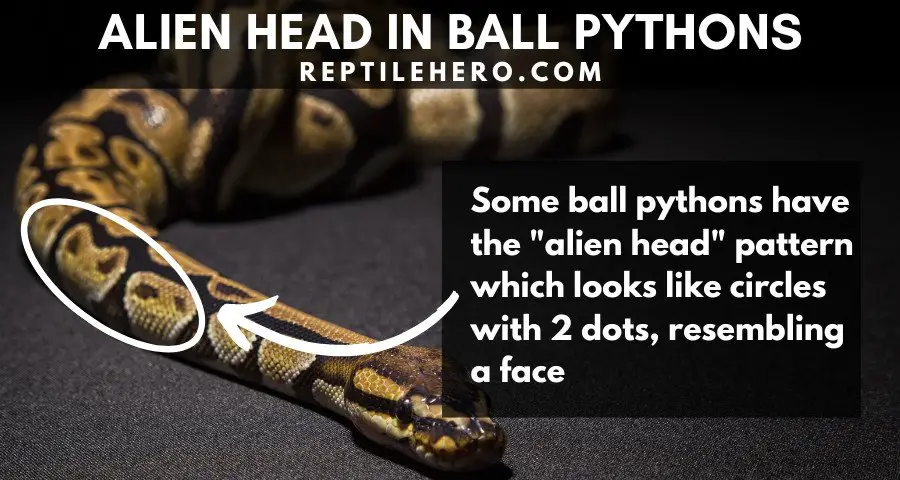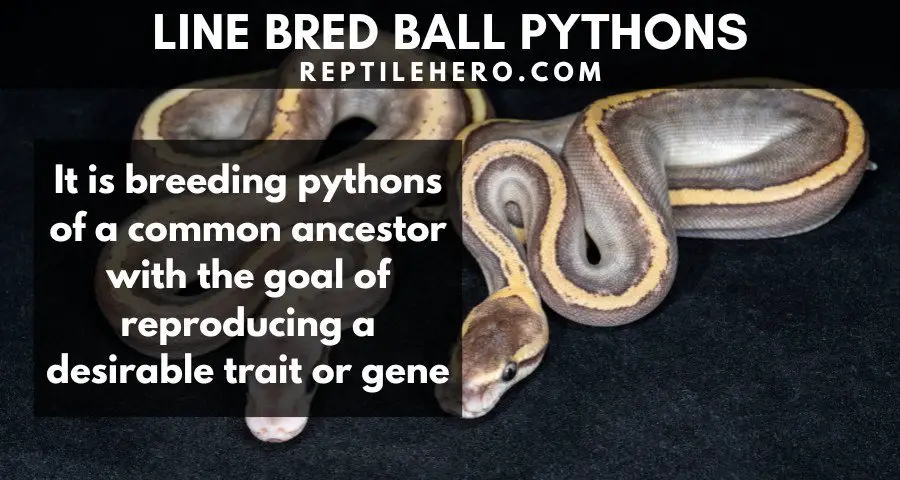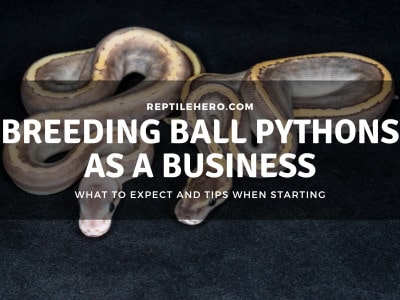9 Rare Ball Python Morphs You Won’t Believe Exist!
As ball python enthusiasts, we love to see new morphs and color combinations for these magnificent creatures. These days, new mutations and morph combinations get discovered left and right!
The rarest ball python morphs are 1) scaleless, 2) tri-tripe, 3) puzzle, 4) stranger, 5) monarch, 6) sunset, 7) rainbow, 8) monsoon, and 9) chimera. These are all genetic mutations that randomly occurred either in the wild or in captive breeding.
Ball pythons have around 4,000-5,000 morphs and it increases as time passes. But out of all these, which are the rarest of the bunch? How much are they and what makes them valuable? Find out more as you read!
1. Scaleless
Scaleless ball pythons lack scales on their whole body except in their belly. They are often lighter in color and have more subtle patterns.
They are produced by breeding 2 scaleless-head ball pythons together. From such a pairing, 1 out of 4 snakes will turn out to have a scaleless body.
Another interesting thing about scaleless ball pythons is their higher humidity requirement compared to all other ball python morphs. In effect, they also shed more often.
This special requirement, alongside low supply, makes them rare.
But don’t worry, even though they have a peculiar look, they can still grow up to be healthy adult ball pythons in captivity.
Even though some ball pythons can be born without labial pits, all scaleless ball pythons don’t have one.
The cheapest scaleless ball python I’ve seen costs around 600–700 dollars. But expect an average price of over a thousand dollars if you’re interested in buying one!
2. Tri-Stripe
Tri-stripe ball pythons have a distinct, thick, line on their back accompanied by 2 thinner lines. Some individuals have spots on the line.
Breeders describe the tri-stripe gene as a pattern disruptor. When mixed with other genes, it will create a beautiful snake with a distinct and clean stripe along its spine.
The tri-stripes is a recessive gene which means that both snakes in the mating pair need to have this genetic code. Simply put, this morph is harder to reproduce and with just a few listings online, it became fairly rare.
Usually, a standard tri-stripe ball python is priced at 1,000 dollars. However, when combined with other morphs, the cost can skyrocket to around 2–6 grand!
3. Puzzle
The puzzle ball python almost looks like a normal morph in terms of coloration. However, a puzzle has a distinct “alien head” pattern that runs on the sides of its body.
If you look closely, you’ll notice that a puzzle-morph python has a slightly deeper tone in comparison to a normal ball python.
Even if it looks plain, the puzzle ball python is desired by breeders due to the nature of its gene to create beautiful, chaotic patterns when mixed with another morph.

The puzzle is a recessive morph that only came out around 2010. Up to this date, it is still one of the rarest ball pythons due to its low supply and expensive base price.
Puzzle ball pythons start at around 1,400 dollars. Their price tag can easily go up to 5 figures when combined with other rare morphs like lavender, and axanthic.
4. Stranger
Stranger ball pythons have a brown-black head with a thin, yellowish stripe along their spine. They also have a black gradient with a series of “alien heads” markings.
The stranger gene is dominant which means. So even if only one of the parents has this genetic code, the trait will be visible in the babies.
It became rare because in 2016 only a few females got released from the original breeder that created the stranger morph [1]. This means that the stranger gene has only been on the breeding scene very recently.
Commonly, the starting price of stranger ball pythons is around 2,000 dollars. But it can go up at around 10 grand when combined with other morphs.
5. Monarch
Monarch ball pythons have a coffee-like color in patches. Their whole body also has deep blushes and patterns that look like a puzzle.
The monarch morph was discovered by a breeder with an odd-looking pastel pair. From this line, the single-recessive gene monarch is produced.
It’s a rare morph because it took 10 whole years to prove that the monarch look was caused by a new gene.
After this, the original breeder released the first few monarchs in the market around 2011–2012. The numbers are increasing up until today but it is still regarded as one of the rarest recessive ball python traits.
In terms of price, 3,000 dollars is the starting point for a monarch ball python. If you want one that’s crossed with other pythons that also have different rare genes, the prices can easily go up to 5 figures!
6. Sunset
Sunset ball pythons have a distinctive, burnt orange coloration with alien head patterns. Their colors are in a gradient, with different intensities of orange and brown throughout their body.
This morph is one of the most impressive, single-gene morphs in all ball python colorations. Unlike other reddish morph combinations, the sunset ball python is only one gene.
Unfortunately, this is one of the rarest due morphs in the market to its limited supply and it is a recessive trait. Starting prices are also very high which makes it a big investment in ball python breeding.
It can cost you at least 4,000 dollars for a sunset ball python. However, when sunset pythons are crossed with other interesting morphs, I have seen listings of over 25 grand!
So if you want to have a full clutch of sunset ball pythons you need to invest at least 8 grand for a pair of hatchlings. You will then need to wait 2–4 years for them to reach maturity and be big enough to safely be paired.
For these reasons, the sunset ball python is one of the rarest and most sought-after morphs in the reptile-keeping community!
7. Rainbow
The rainbow ball python has a unique color combination of yellow, lilac, and orange. It is also a recessive-gene morph first produced in 2015.
Many keepers compare this morph to a coral glow. The difference is that the rainbow is recessive and has a slightly more intense coloration.
The rainbow gene also has a different effect when crossbred with another morph.
Rainbow ball pythons are rare due to their incredibly low supply. As a result, it’s also really pricey.
Interestingly, the demand is not that high since it almost looks like a common coral glow.
Still, one rainbow ball python will set you back by 4,000 dollars. When combined with other morphs, the price can go over 10 grand.
8. Monsoon
The monsoon ball python morph is a recessive gene that has a shattered pattern. The coloration can be described as a gradient mixing olive green, brown, and yellow.
Monsoon is another recessive-gene morph. But it is unlike any ball python morph seen before. Some keepers even describe monsoon ball pythons as having labyrinths on their backs.
The funny thing is, this morph has been discovered by accident by one breeder. You can even see his first forum post asking what this strange morph is!
It became super rare because it came from only one breeder and the starting price is very high. This beauty can easily cost you 14–15 grand—minimum!
Even the non-visual ball pythons or the “het monsoons” can cost around 2,000 dollars, sometimes even more.
So imagine, to possibly breed this morph you need to have at least 4–5 grand to buy a pair for a 1-in-4 chance of producing a monsoon. Keep in mind, these prices are just for hatchlings.
You need to allot 2–4 years for the pairs to grow into adults before you can start your breeding project with them.
9. Chimera
A chimera ball python is a fusion of 2 individual python morphs that results in their patterns being split in half. This is an anomaly that randomly happens in breeding. Some speculate it is only one in a million chance.
The patterns of a chimera can either be split in half horizontally or vertically. Some specimens only have this genetic mutation on certain parts of the body like the head.
This morph cannot be reproduced, thus making it very rare. Many even consider it a priceless morph.
Since a chimera generally refers to a creature that is created by fusing different animals together, you can expect problems like infertility to arise in ball pythons with a morph sharing this name.
Chimera ball pythons are essentially the result of fusing two different fertilized ova into one embryo. They are not conjoined, but a chimera’s genetic material consists of two individual animals.
>>Learn more about birth defects in our article ball python morphs with problems.
But don’t worry, chimera ball pythons grow like normal ball pythons in terms of general care.
The cheapest chimera ball python I’ve seen is about 2,500 dollars, but the average price is highly dependent on how much the seller is willing to let go of these rare specimens.
Depending on the morph combination, the price of a chimera ball python can even go as high as 15–25 grand.
What Makes a Ball Python Morph Rare?
Ball python morph rarity depends on the supply of and demand for a certain morph. Highly sought-after morphs with low supply in the market are typically the rarest ones.
Just to help you gain a better understanding, let’s focus on the sunset ball python and why it’s rare even though it has been in the market for years.
The founder of the sunset ball python reportedly took almost 10 years to prove that this is indeed a recessive gene, not an anomaly like chimeras.
He shared that he got one, weirdly orange ball python and after breeding it to a normal female, he produced all normal babies. Then, these babies are bred to the original male and produced what we now know as the sunset ball pythons.
So when he listed these babies on the market, prices go up to around 10–20 grand due to very high demand and very low supply.
Until now, sunset ball pythons are normally priced at a couple of grand each. This means only a few people are willing to invest resources to produce these beauties since it’s a very time-consuming breeding project.
>>Do you have a ball python for sale? Check out our article on selling ball pythons!
Where Do Ball Python Morphs Come From?
Ball python morphs available today come from either a mutation from wild specimens or through captive breeding. Morphs like albino and pied came from the wild snakes while scaleless and monsoon came from captive ones.
In the dawn of the ball python community, most genetic mutations or morphs came from wild-caught snakes caught by trappers in West Africa.

These morphs are then “line-bred” by past keepers to produce the same color mutation with the hopes of incorporating it with other morphs.
The concept is generally the same with newly discovered mutations in captive breeding. So it is only by chance that certain genes are discovered.
However, ball python combinations are bred in captivity. So popular combinations like the batman and bumblebee are produced with the aid of breeders.
Due to their vast mutations, one study even speculated that genetic engineering with ball pythons is possible in the near future [3].
Further Questions
What is a paradox ball python?
A paradox ball python is another anomaly with two types the mosaic and the chimera. Mosaics only express contradicting qualities on a subtle level while the chimera is an extreme version of this.
What is the first ball python morph produced in captivity?
The first successfully recorded ball python morph bred in captivity is the albino. This morph was first found in the wild around the 90s. Then it was produced in captivity after a keeper bred an albino het ball python with an albino one.
Summary of the Rarest Ball Python Morphs
Some of the rare ball python morphs are scaleless, tri-stripe, puzzle, stranger, monarch, sunset, rainbow, monsoon, and chimera. All of these morphs can be naturally reproduced except the chimera.
The rarity of a ball python is determined based on the supply and demand of the specific morph. Genetic mutations with the highest demand and lowest supply are the rarest and most expensive.
In general, morphs or genetic mutations either come from natural pairings of wild specimens in their natural habitat or during captive breeding. Genes like pied, albino, and monsoon are found unexpectedly and are bred in captivity to produce pythons with the same mutations.
Sources
[1] https://www.ires-reptiles.com/the-ball-python-stranger-gene.html
[2] https://digitalcommons.usu.edu/cgi/viewcontent.cgi?article=2004&context=etd






